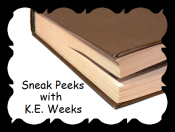 |
| This feature is presented by guest blogger, K.E.Weeks. |
book is compelling and interesting. I finished it in two days.

Crossing the Tracks
This novel, which was a William C. Morris Debut Award finalist, is well-suited for mature young women. While I enjoyed the book, some of the subject matter may not be appropriate for readers under thirteen. Iris starts her period shortly after she reaches the Nesbitt household, so there are several chapters dealing with this new development and the related embarrassing logistics of living with strangers far from town without feminine supplies.
Spoiler Alert! Secondly, parts of the plot hinge on adult themes, such as domestic abuse, teenage pregnancy, drunkenness, and incest. This is 1926, so any scandalous matter is quickly “swept under the rug,” but the suggestions are there for the astute reader. Moreover, there are very subtle hints about homosexuality. One scene has Iris asking some imaginary Greek goddesses for advice, which strikes me as a little like praying to false gods, but it is only mildly offensive because she doesn’t actually pray and it is an isolated incident.
Lastly, Iris and her boyfriend have a couple of kissing scenes. Overall, the romantic scenes are tender and mild—light kissing on a back porch, lying on the grass together looking at the stars, back massages—, but a naive student might be shocked by these unchaperoned encounters.
While the novel contains all of these potentially explosive themes, it isn’t a racy novel. In fact, it is a rather sweet story, with realistic situations. It would be a good book for a young woman who was dealing with the death of a loved one because there is a lot of discussion of grief and loving suggestions for how to grieve, such as this scene between Iris and Mrs. Nesbitt who has lost her husband and other son:
One by one, my hands and the rag cherish her things for her.
After a while she says, “I find that dusting brings out memories, Iris, the way
rubbing a magic lamp releases the genie.”
I nod to be polite, but...but what if your genies are asleep, or dead? What if your memories never had a chance to get made?
“My mother has passed on too.”
Mrs. Nesbitt looks heavenward, her eyes glistening. “We’ll need to dust together every day” (Stuber 44).
The book is full of rich and eloquent imagery. For instance: “The wind explores the morning, fills my sleeves, twirls up my skirt, ruffles the robins, then switches destinations, and so do we. As we crest a hill I feel the earth release us, then hug us tight going down. Emerald corn fields rustle under the scalloped telephone wires” (Stuber 85).
I liked this book in a quiet way. The vivid language and tranquil setting are peaceful. The action satisfies my desire for justice and invokes emotion. I rate it four stars (out of five) and recommend it for mature middle school and high school young women.
Disclaimer: The purpose of this review is to guide parents into selecting appropriate, significant, high-quality literature for their teens and tweens. I have no connection with the author or publisher of this book. I am a home educator of two children, 12 and 14, with a Master of Art degree in American Literature and a keen interest in young adult fiction and nonfiction.
2 comments:
I was a homeschool mom for three years and this year my daughter is in the sixth grade in public school. She picked out this book to read and I feel like I should read it with her and then I could discuss some of it with her. She will be 12 in November. The book is Crossing the Tracks. What do you think? Just curious.
Yes, I would recommend reading the book with her and discussing it. While this is an excellent book, there are some themes that might be a little dicey for a 12yo. K.E.Weeks
Post a Comment